Three, Two, One… Kimchiiiii. After a trip to Seoul, now and forever, I am prepared to yell kimchi whenever someone wants me to smile for a photograph, because saying cheese is so passé! But kimchi, that side dish made of fermented cabbage that’s become synonymous with Korean food, is just one of the many dishes of Korea. The streets of Seoul are a crowded palate, where traditional fare coexists with cafes and chicken-and-beer joints, the latter fairly recent imports. Seoul’s streets, in fact, probably have the highest density of coffee shops and beer joints—out of thirty shops, twenty are certain to be these.
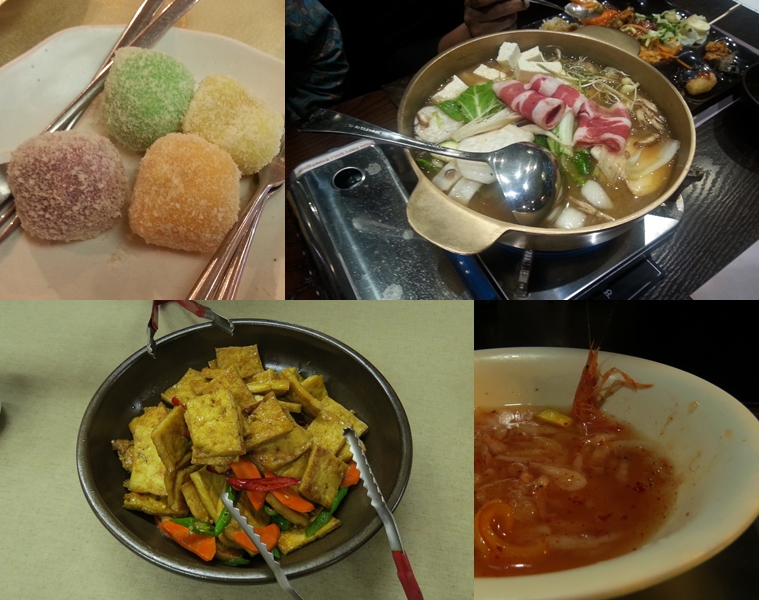 (clockwise from top-left) Sweet rice cake covered in sugar; a hot broth with raw meat that’s cooked on the table; tofu cooked without onion and garlic; and shrimp sauce. (Source: Shruti Chakraborty)
(clockwise from top-left) Sweet rice cake covered in sugar; a hot broth with raw meat that’s cooked on the table; tofu cooked without onion and garlic; and shrimp sauce. (Source: Shruti Chakraborty)
A Korean plate looks much like it does in the eastern and north-eastern parts of India. There is rice at the centre (sticky rice in this case), and a host of accompaniments, ranging from vegetarian (seaweed, fried or steamed ); nabak kimchi (sweet, pungent watery kimchi that I personally liked); tongbaechu kimchi (traditional spicy kimchi that I stayed away from after the first two times); juk (a vegetarian congée that can also cure a hangover); pajeon (savoury flour pancakes with all sorts of vegetables); dotorimuk (a rather tasteless acorn jelly–stay away), various preparations with tteok (steamed rice cakes made with glutinous rice, glass noodles) to meat (a variety of raw fish; jogaetang (neck clam soup with vegetables; beef ribs; jjukkumi (stir-fried baby octopus), mollusks).
But if you don’t have time for a traditional, sit-down Korean meal, then it’s Seoul’s streets that you should be looking for. So, bring out your brass/gunmetal chopsticks (the Koreans prefer metal chopsticks to the wooden ones popular in China and Japan, though they first started off with silver because of its healing properties), the soup spoon, and tuck right in. Some markets like Gwangjang have many food stalls with a variety of meats, and makeshift seating all around like a bar. They serve Soju, beer and green tea (which is offered as a pacifier should you choke on your food like I did) as beverages.
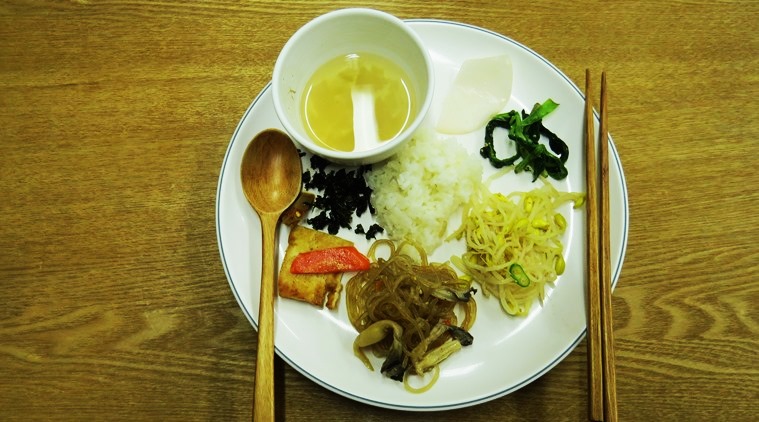 A plate of ‘sattvik’ traditional Korean food available at the many temple stays. (Photo: Shruti Chakraborty)
A plate of ‘sattvik’ traditional Korean food available at the many temple stays. (Photo: Shruti Chakraborty)
Here’s what you can chew your way through on a food crawl to the many hawkers’ markets in the city (Nandaemun, Myeongdong, Gwangjang and Insadong are where I ventured).
Tornado potato: This may not be traditionally Korean, but once you’ve had your deep-fried potato wafers spiralling up a long skewer, brushed in your choice of flavoured powder — onion, honey and cheese — it’ll be quite a while before you pick up your next packet of chips. If you’re lucky, you’ll find one with spliced sausages in between.
Sausage and rice cake skewers: Nibble on different kinds of sausages and rice cakes barbecued on skewers smothered in a traditional Korean sauce.
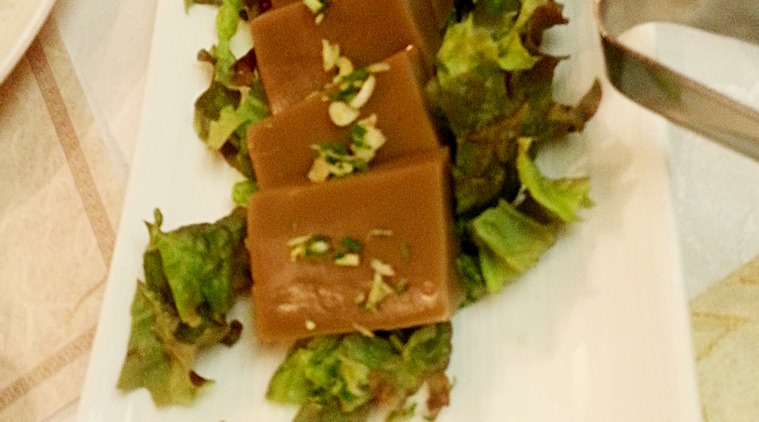 Dotorimuk, a jelly-like dish made from acorn. (Photo: Shruti Chakraborty)
Dotorimuk, a jelly-like dish made from acorn. (Photo: Shruti Chakraborty)
Gyeranppang or egg cake: This snack is made by cracking an egg on a fat piece of cake and baking it. The sweet of the cake and the richness of egg gives it an interesting flavour and texture.
Ttoekbokki: Devilishly hot, this is a hugely popular snack. Rice and fish cakes are dipped in hot and sweet tomato-based red chilli sauce and boiled over a portable stove. It’s best washed down with a bottle of Soju.
Oysters, butter and cheese: I’m not quite sure what this was called, but it looked delicious. Fresh oysters, roasted over the fire with cheese and chunks of butter, and a slight salty seasoning. The oyster is cooked in its shell and is served with the butter bubbling hot.
Soondae: Korean version of blood sausage, a common variety is pig’s intestine mixed with noodles/rice, barley and pork blood. This is also tossed in red chilli sauce (a favourite with Koreans, it seems) and served hot. An interesting tangy shrimp sauce is served on the side that’s full of tiny shrimps (eyes and everything), should you want to dip your pork for some fishiness.
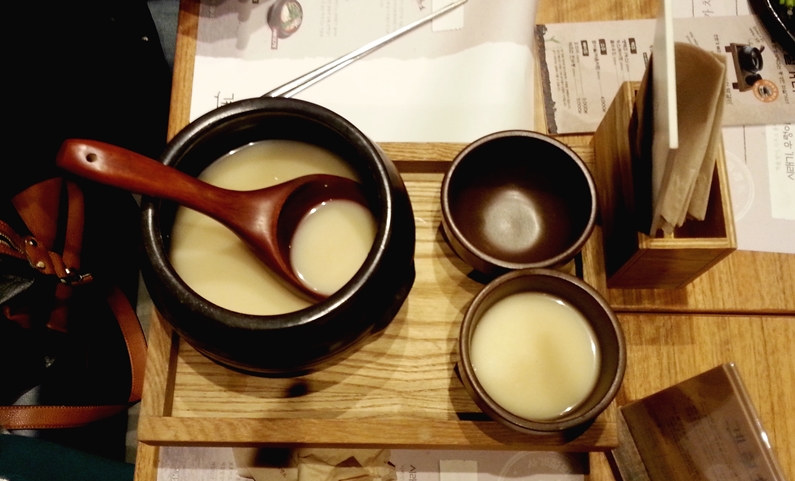 Makgeolli, a milky white rice wine that’s sweet, earthy and leaves you warm and fuzzy. (Source: Shruti Chakraborty)
Makgeolli, a milky white rice wine that’s sweet, earthy and leaves you warm and fuzzy. (Source: Shruti Chakraborty)
Jjukumi: Baby octopuses are quite popular and you can find them everywhere — stir-fried, battered, roasted or tossed in a red chilli gochugaru sauce before being fried. A bit tricky to eat, they taste like squids, only a bit tougher. Some stalls also offer octopus arms, which are much bigger but taste almost the same.
If food is on its way, can drinks be far behind? There are two local brews to wash down all that food: Soju and Makgeolli. Made from rice, wheat, barley or even potatoes or tapioca, Soju is the most popular drink in South Korea. It’s a clear distilled drink containing ethanol and water, with an alcohol content of up to 45 per cent. As I downed it neat in tiny shot glasses, Soju was more of a checkmark in my list and did nothing to uplift my spirits. What really stayed back with me, though, is the Makgeolli, a milky white rice wine that’s sweet, earthy and leaves you warm and fuzzy. Said to be a farmer’s liquor, it is now gaining popularity among the young city crowd as well. For those who like to experiment, add a dollop of sweet potato ice cream into a bowl of Makgeolli for a delicious float. It’s life changing.
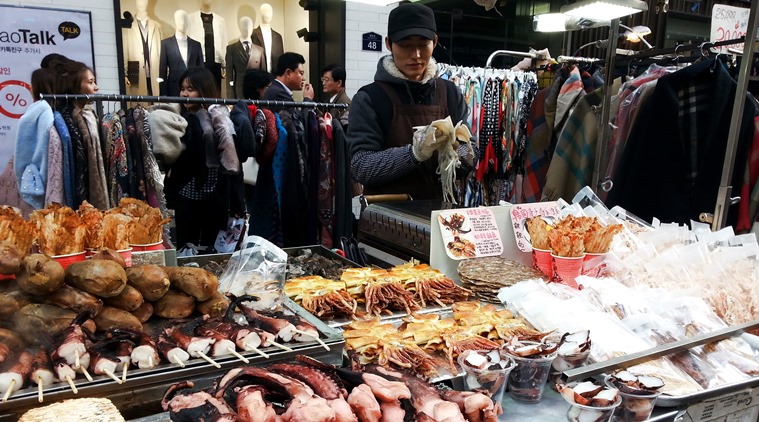 A street-food vendor at Myeungdong market. (Photo: Shruti Chakraborty)
A street-food vendor at Myeungdong market. (Photo: Shruti Chakraborty)
If you still have appetite for some more, you can finish off with these desserts.
Kkultarae or dragon’s beard or Korean court cake: It’s a mildly sweet bite-sized nugget of fine strands of ‘hair’ made by meticulously pulling a honey-maltose mixture. The filling can be varied, from assorted candied nuts to chocolate.
Hotteok or sweet pancake: This is best had hot. The pancake is filled with a mixture of brown sugar, honey and chopped nuts. Eating it can be quite challenging as the molten sugary centre tends to drip on to your arm and scald it. But totally worth it.
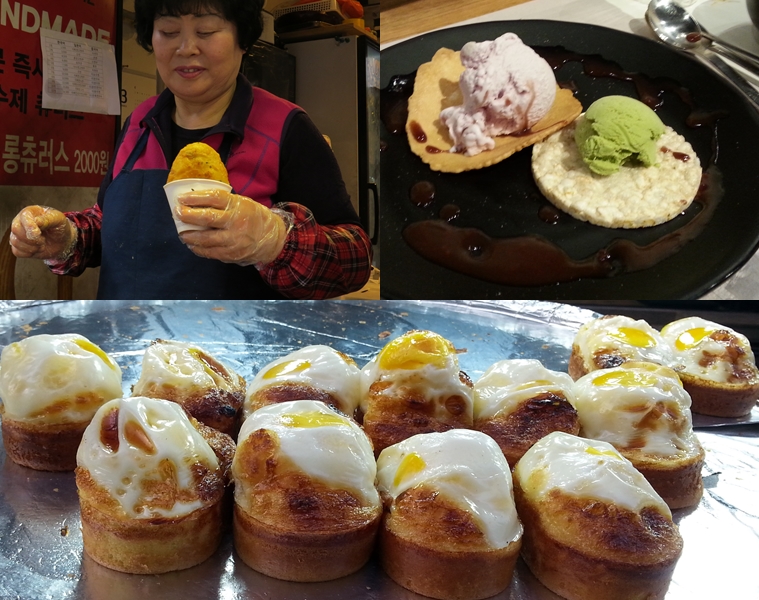 (clockwise from top-left) Hotteok; sweet potato and green tea ice creams, served with red bean sauce; and Gyeranppang or egg cake. (Source: Shruti Chakraborty)
(clockwise from top-left) Hotteok; sweet potato and green tea ice creams, served with red bean sauce; and Gyeranppang or egg cake. (Source: Shruti Chakraborty)
Sweet tteok: This is just a sweet version of the rice cake, with or without a nutty-brown sugary/red bean paste filling, and a powdered sugar coating. Not very sweet, the gooey balls are actually quite tasty in this form. This is also a traditional Korean wedding sweet.
Sweet potato ice cream and red bean paste, though not necessarily together: The Koreans love their ice creams and have some unique flavours, and like other parts of South East Asia, they love a lot of sweet red bean paste (that’s rajma for us) in their desserts. I loved the sweet potato flavoured ice cream and a spoonful of sweet red bean paste with it. The more popular version is patbingsoo, which is a dollop of ice cream on a bed of ice shavings and red bean paste, topped with seasonal fruits.
Despite all this food, my rather tight schedule didn’t let me try the two things I really wanted to — bulgogi, spicy marinated beef strips barbecued to crispy yet succulent perfection and beondegi, steamed or boiled silkworm pupa, which is supposed to taste nutty. Well, maybe next time.
The author was part of an Indian women journalists’ delegation to Seoul, South Korea.